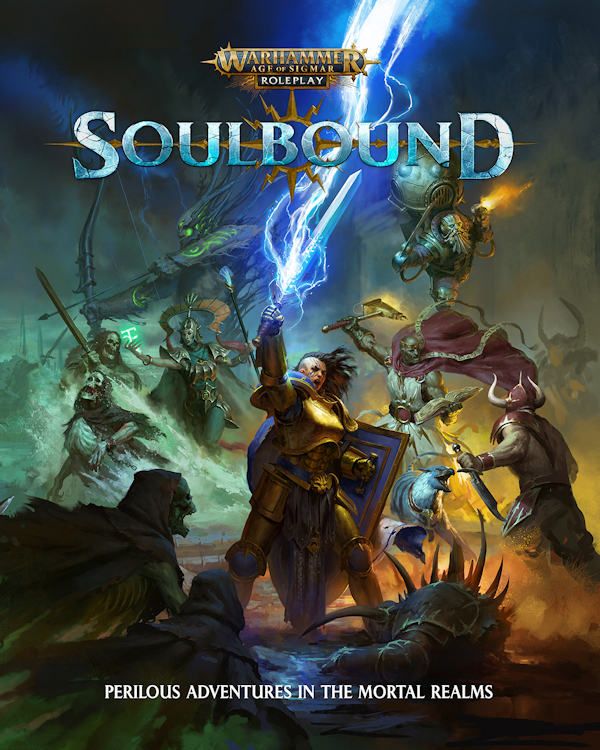 Big, bold, bombastic, and brutal—Age of Sigmar: Soulbound has swaggered its way onto the RPG scene with well-earned confidence. Players take on the role of larger-than-life heroes (literally, in some cases) at the forefront of the battle between the forces of Order and the hordes of dead, damned and demented foes who oppose them. Immortal knights, soul-eating sea-elves, flying steampunk machine-gun dwarves, giant treemen, and more fight through a world of high action, high magic, and high stakes. It’s a game with grimdark tattooed on one fist and noblebright tattooed on the other.
Big, bold, bombastic, and brutal—Age of Sigmar: Soulbound has swaggered its way onto the RPG scene with well-earned confidence. Players take on the role of larger-than-life heroes (literally, in some cases) at the forefront of the battle between the forces of Order and the hordes of dead, damned and demented foes who oppose them. Immortal knights, soul-eating sea-elves, flying steampunk machine-gun dwarves, giant treemen, and more fight through a world of high action, high magic, and high stakes. It’s a game with grimdark tattooed on one fist and noblebright tattooed on the other.
Age of Sigmar is a new RPG, but one with a great deal of history behind it. Let me summarise as best I can.
Warhammer Fantasy was the flagship game of Games Workshop, the most successful tabletop wargames and miniatures company in the world. As well as being one of the most influential and beloved wargames of all time, Warhammer Fantasy spawned its own RPG that soon developed a devoted fanbase, despite never achieving the commercial success of the wargame.
The world of Warhammer was a grim and gritty place, but full of tongue-in-cheek humour. It had serious and horrific villains and noble yet flawed heroes. And it had crazed ratmen who constantly betrayed one another and green fungal orcs who were basically football hooligans with axes. (Those lads are the reason why orcs are often portrayed as green in modern fantasy.)
The world of Warhammer was also doomed. It was generally acknowledged that the forces of Chaos (really the forces of Evil) would eventually overwhelm the crumbling kingdoms of mankind.
One day, Games Workshop made good on that promise. They told the story of the apocalypse which destroyed the Old World of Warhammer and ended the game line. (I’ve seen many different reasons given for this. But two common threads are falling sales for the original line and the desire to focus on their sci-fi fantasy game Warhammer 40,000, which had proved to be more commercially successful than its ‘pure fantasy’ counterpart.) Fans of the Warhammer Fantasy wargame and RPG were unhappy, to say the least.
Then, GW performed a curious act of setting resurrection. The shattered remnants of the Old World coalesced into eight realms of near infinite magnitude. A friendly star-dragon helped Sigmar (once god of the largest and most powerful human nation in the Old World) discover these realms and rekindle the flame of civilisation within them. Many peoples and even individuals who had perished in the fall of the Old World lived once more in these realms. New creatures and peoples also arose, thus allowing the creation of interesting new models to sell.
When Chaos rose again and destroyed almost everything Sigmar had wrought, he retaliated by taking the souls of past heroes and hammering them into near-indestructible knights, and leading them in a grand war of liberation which still rages to this day.
That is the backstory for the Age of Sigmar wargame and for the Stormcast Eternals, its signature army.
Soulbound is the first RPG set in that world. It has its work cut out for it—appeasing the fans of the old Warhammer Fantasy RPG on the one hand, and selling the idea of RPGs to a new generation of wargamers on the other.
Introduction
The book starts with a quick and gentle intro—explaining the core concept of the game, the nature of an RPG, the way the book is laid out and the basic rules of Soulbound within the first two pages.
This is an extremely well laid out and thought out book. Text boxes explain exceptions and alterations to the rules and interesting bits of lore. Notes in the sidebar tell you which page to turn to if you want to know more about a particular concept or rule. Key rules are repeated at multiple points, so you don’t have to flip back to check them. It’s very easy to read and understand. Which is good because this book has a lot of information to convey.
The rules set for Soulbound is fairly straightforward. The GM works out a Difficulty number from 2 to 6 and determines how many Successes are required to complete the task or action a character is attempting. The player adds an appropriate Attribute to an appropriate Skill. That is the number of six-sided dice they then roll. Every die that matches or beats the Difficulty number is a Success. If the character has one or more points of Focus in that Skill, they can add them to the number rolled on a particular die to turn it into a Success, or spread them over several dice to gain multiple extra Successes.
The backstory of Age of Sigmar, on the other hand, is epic and complicated.
An unbeatable alliance between Sigmar and other gods, most of whom abandoned or betrayed him in the end. Great battles, the defeat of Order, the sealing of the celestial realm of Azyr, and the abandonment of the other seven Realms to Chaos. The gathering of the Stormhosts. The Great Waaaaagh! The dreaded Necroquake.
The writers are clearly aware of this and aware people often skim over the fluff in gaming books. So, when telling the backstory, they switch from the book’s normal two-column format to a single column of larger text, intercut with richly detailed pictures of savage battles, mighty gods and epic deeds. (The art is pretty top-notch throughout this book—colourful, lively and imaginative.)
“The God-King had presented Chaos with the first unified effort at resistance in an Age. And Chaos exulted.”
The backstory ends by directly tying the conflict back to the players. They will take on the roles of Soulbound, a revived order of heroes chosen by the gods to have their souls glued together. They are the best hope Sigmar and his allies have of triumphing over the forces of Chaos, Death and Destruction.
Character Creation
Character creation is a fairly involved process in Soulbound, but the book goes out of its way to make it as straightforward as possible. It’s easier than 5th edition D&D, put it like that.
The book presents five playable species—Humans. Aelves (elves). Duardin (dwarves). Sylvaneth (tree-people). And Stormcast Eternals (superhuman, nine-foot-tall celestial warriors who are endlessly reincarnated). Each species gets a little bonus, like being a bit harder to kill, but otherwise the only effect species has is determining the cultural and Archetype options available to the character. (And the game is cool with you mixing those up if you really want to.)
There are three main stats in Soulbound—Body, Mind and Soul. Body covers most physical tasks from close combat and dodging to athletics and manual dexterity. Mind is used for anything that requires intelligence or awareness and includes non-magical ranged attacks. Soul, appropriately, is a bit more nebulous. In the writer’s own words, it is “your sense of self, your spirit and determination, and your ability to resist the influence of Chaos.”
There are also derived stats. Initiative is fixed (as it always should be, systems that make you roll randomly for Initiative are wrong, don’t @ me) and is based on a character’s Mind. A stat called Mettle is based on Soul. We’ll come back to Mettle.
There are optional tables to help players pick out their character’s appearance if they’re struggling on their own. There’s also a list of ten questions to help define a character’s backstory and motivations, a good feature for assisting new players through the process of making a character.
In an interesting move, the book has a section on creating your Party or Soul Binding of Player Characters (PCs). What brought the Binding together? What does their divine patron want from them? What connections have they already forged? How much Soulfire do they have? (We’ll come back to that as well.) The book provides a Party Sheet for keeping track of all this stuff, which is an excellent idea.
The book presumes you will pick an Archetype, which determines your character’s stats and provides lists of Talents and Skills to choose from (all of this is explored in later chapters). This method makes it relatively easy to put together a new character. When making characters for a one-shot game, I could follow the Archetype method and make a new character in an hour or so, (skipping over character background). The extra time was mainly due to having to go and check back derived stats and a few other details; it would get quicker after you’ve run through the process a few times. (Though bear in mind I didn’t worry about creating a backstory for the characters.) You can also create a character, Species or Archetype from scratch if you want to.
This whole chapter is particularly useful and welcoming for new players and GMs as it’s stuffed full of advice on subjects like—making your character memorable, how to avoid interpersonal conflict in the group and why you should talk to the rest of your group about the direction the campaign should take.
Archetypes
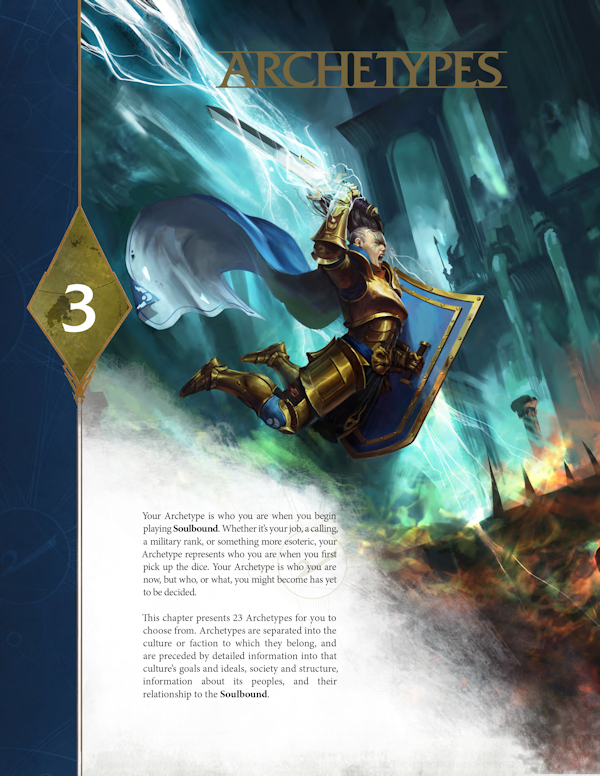 This chapter talks you through the standard character options available to players. These Archetypes are cool concepts based, mostly, on models from the Age of Sigmar wargame. There are 23 Archetypes in all and I haven’t had this much fun reading through character options since I finished my review of Spire!
This chapter talks you through the standard character options available to players. These Archetypes are cool concepts based, mostly, on models from the Age of Sigmar wargame. There are 23 Archetypes in all and I haven’t had this much fun reading through character options since I finished my review of Spire!
The Archetypes are grouped into cultures. Each culture gets a bit of further explanation to help a player portray them. Each culture also gets a very useful section on why their members would become Soulbound (which is expanded on in the individual Archetype descriptions). This is really helpful as it’s not that easy for anyone new to the setting to understand why e.g. a bloodthirsty and paranoid Witch Aelf would want to abandon her murder-cult to fight alongside shining champions of goodness. (Or what would motivate her even more paranoid and bloodthirsty goddess to allow such a thing.) The cultures are:
- Fyreslayers: Patriarchal dwarves who seek to resurrect their fallen war-god by collecting magic gold, shaping it into runes, hammering those molten runes into their own flesh, then going out and fighting until the magic in the gold dissipates. (Because apparently the Old World Dwarven Slayers weren’t hardcore enough.)
- Kharadron Overlords: Dwarves who escaped the horrors of the Age of Chaos by building massive steampunk sky cities. While most other characters use swords, spears and bows, the Kharadron rock machineguns, buzz-saws, drill-cannons, flamethrowers and acid launchers. Also, they all fly around the battlefield on magic steampunk jetpack-balloons.
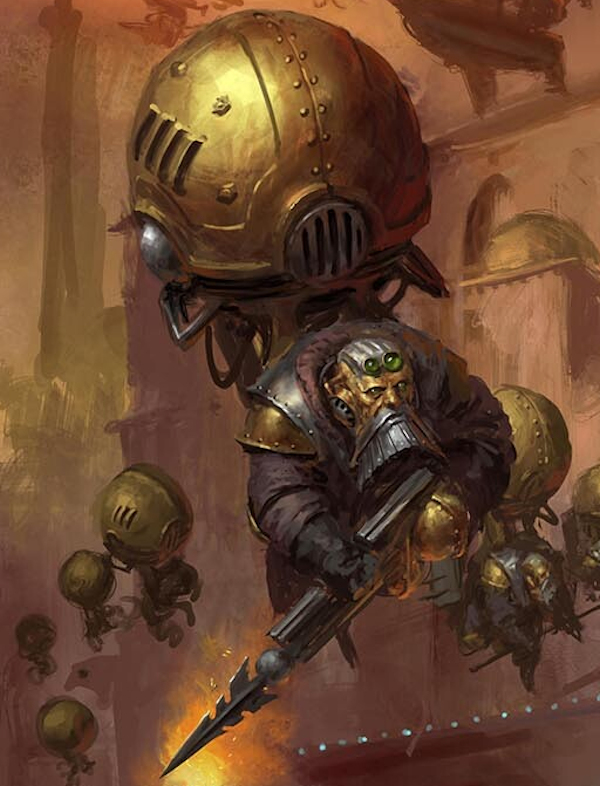
- Daughters of Khaine: Khaine is an elven god of murder and bloodshed who is legally distinct from the suspiciously similar Chaos god Khorne—patron of war and bloodshed. His Daughters run around wearing not very much and stab people for religious reasons. (Chaos may be evil, but Order isn’t necessarily good.)
- Idoneth Deepkin: Elves with (literally) flawed souls who live underwater and ride sea-monsters into battle. They are a grim people who shun all sensation and prey on the surface folk to steal their souls, which are used to bolster the Idoneth’s own failing bodies and spirits. (But it’s okay because they hate Chaos enough to occasionally ally with Sigmar’s forces.)
- Free Peoples: A catch-all term that covers pioneers, human battlemages, ruthless elven corsairs and Sigmarite warrior-priests. Also, the Darkling Covens, spooky, elven sorceresses allied to the Daughters of Khaine.
- Sylvaneth: Beings of living wood and spirit, they serve the goddess of life, Alarielle, and are divided into several sub species. These include the towering Ent-like tree-warriors called Kurnoth, and the eerie Tree Revenant, who remembers battles and adventures long past.
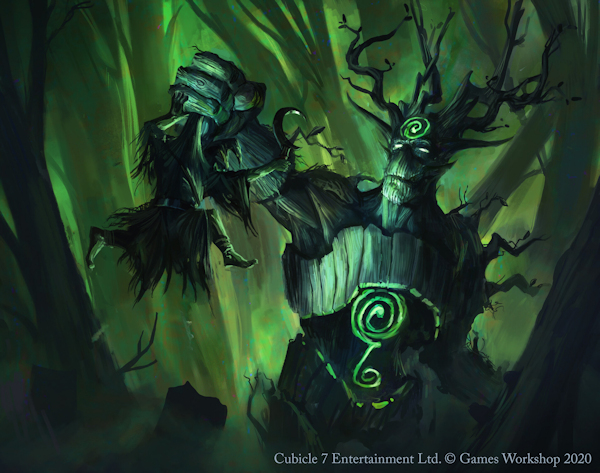
- Stormcast Eternals: The aforementioned superhumans. Stormcast cannot be Soulbound and so lack one of the greatest advantages PCs in this game receive. To balance this out they’re just better than everyone else and have armour that can’t be broken. Some of them can fly too.
I was disappointed the Seraphon (magically summoned Order-worshipping lizardmen with a Meso-American feel) weren’t a playable option. Perhaps a future supplement will offer them.
The Archetypes on offer are pretty damn awesome. They tend to be focused on either arcane magic, divine miracles, close combat or ranged combat but the flavour, weird equipment and individual abilities that go with them make them seem far more diverse than that. When I was picking characters for a one-shot, I found it almost heartbreakingly difficult to pick out just five characters to offer to my players. And they all had fun playing their different Archetypes and all got a chance to do something cool and to be the centre of attention. I was pleased to see the more martial characters didn’t feel at all limited or underpowered compared to the magic-wielders.
As a final note on this section. The book points out that, although some Archetypes use gendered terms, a character of any gender identity can play them. Laudable. And, fair play to them, there’s a picture of a blood-drenched and battle-scarred female-presenting Fyreslayer in the next section to back that up.
Skills and Talents
You won’t really understand an Archetype’s capabilities until you look through this chapter. There are twenty-four Skills, covering a reasonably broad array of situations. The game has an emphasis on combat, so you have Weapon Skill for stabbing things and Ballistic Skill for shooting things as well as Skills for casting miracles and spells, sneaking, dodging, being strong, resisting fear and corruption and patching up your friends. But there are also Skills for knowing things like history and magical theory and which mushroom is safe to eat, as well as Skills for social interaction.
The Talents are more unique and grant bonuses or extra abilities. This is really where one Archetype is differentiated from another in mechanical terms. Spellcasting is a Talent, as is casting Miracles. Some Talents could be taken by multiple Archetypes or cultures, while others, like the Aether-Khemists Guild Member, are very specific and unlock specialised equipment or showcase an Archetype’s unique shtick. Again, there’s an emphasis on combat but it’s not the be-all and end-all.
Witch Aelves can fall into a Blood Frenzy—getting better at fighting each turn as long as they shed some blood the previous turn. Tree Revenants can channel their Martial Memories to gain varying bonuses in combat. Every combat style has at least one Talent associated with it. Here’s a random sample, you can: fight with two swords or two guns, wield massive weapons effectively, shoot a hail of arrows, punch through armour, fight more effectively against a crowd of opponents, or throw a fireball without barbecuing your friends. There’s even a Talent for repairing armour in the middle of combat! (And an extremely vicious Talent which lets you sever an enemy’s tendons so they can’t run away.)
You do have roguish Talents too such as the ability to fall off things with style, disguise yourself or creep through back-alleys unseen. And a few more academic Talents such as Forbidden Lore and Scholar.
This chapter also includes a section on Miracles.
A starting character blessed by a god gets the ability to cast a single Miracle and can purchase more with XP as a campaign goes on. Some Miracles require the spending of Mettle to activate. All Blessed characters can choose from a handful of universal Miracles that cover the standard support-character abilities of healing and granting bonuses to attack and defence. Each god grants five of their own Miracles as well, making one Blessed character potentially very different to another.
- Alarielle, the goddess of life, has some relatively subtle miracles. Controlling the surrounding terrain, detecting life, briefly growing claws or gills.
- The Ethersea is not a god but the Deepkin can use it to cast Miracles anyway. Pretty awesome miracles too. Summon a tidal wave. Shatter a target’s living soul. Track a soul anywhere in the realms
- Grimnir, the dwarven smith god, summons volcanoes, melts metal objects and does something called Magmic Tunnelling, which I’m just going to leave to your imagination.
- Khaine, the elven blood god, is probably dead but still provides miracles. His followers can manipulate emotions, freeze an opponent in place, or rip the blood out of someone with a gesture. (I’d say you’d want to meet them on a good day but there really isn’t ever a good day to meet a follower of Khaine.)
- Sigmar himself focuses on daemon-slaying, lightning, weaponised sunlight and bolstering the faithful.
Equipment
This chapter begins with a mercifully brief description of how trading and acquiring goods works in the setting. There are equally quick and to-the-point descriptions of lodgings, transport, and tools. Enough to inform without taking too much time away from the fun stuff.
I did like the hirelings section. Rather than being disposable minions used to balance out the lethality of combat, hirelings are specialists who provide the party with a useful extra Talent e.g. a cook who can make nourishing and healing meals, or a scout who ensures the party never gets lost. It’s a very neat little system.
A standout point is the form of currency used in the Realms. Did you think all those thousands of gold coins and gemstones in D&D were a bit silly? Forget that, the primary currency in Age of Sigmar is drops of Aqua Ghyranis aka magical water from Ghyranis, the realm of life. Aqua Ghyranis in sufficient quantities can stimulate plant growth to an insane degree and even cleanse an area of the corruption of Chaos, making it extremely valuable. Aqua Ghyranis also saves you the bother of buying healing potions because a hundred drops of it is a healing potion. Which is delightfully convenient. My players were amused to discover they could heal their characters by having them drink money.
I like Aqua Ghyranis. It underlines the bizarre, high fantasy aesthetic of Age of Sigmar. (Particularly since other, weirder, currencies are available.)
Moving onto weapons.
There isn’t a massive selection of these. Soulbound is one of those games that assumes a slicey, curvy sword with extra spiky bits and a short, stabby sword are both just swords really. (Except for swords made of sigmarite, which have a better time damaging ghosts.) I personally prefer more complexity in weapons such as you might get in games like Black Void, but I understand the game design decision to keep things simple.
Players of Zweihander or Warhammer Fantasy Roleplay will be at home in this section. Each weapon type has a damage rating but also various descriptors that alter its abilities in some way. A hand hammer, for example, is like good satire—both subtle and crushing.
Armour is light, medium or heavy with an optional shield on the side. Sigmarite armour is impervious to weapons, spells or Miracles that damage or transmute armour. Because the Stormcast Eternals are better than everyone else. Fyreslayers get golden runes that variously grant bonuses to hit, armour, toughness and damage, as well as a couple of other useful effects.
The Other Equipment and Kharadron Equipment sections are the most fun.
Here we are treated to such items as teleportation bagpipes, combat buzz-saws, mechanised hammers, vacuum guns, drill guns, gasmasks, skyhooks, vulcaniser pistols, artificial angel-wings, and magic cloaks that let sea creatures ‘swim’ through air. It’s awesome. And the book’s punchy rules and layout make it all pretty easy to digest and understand.
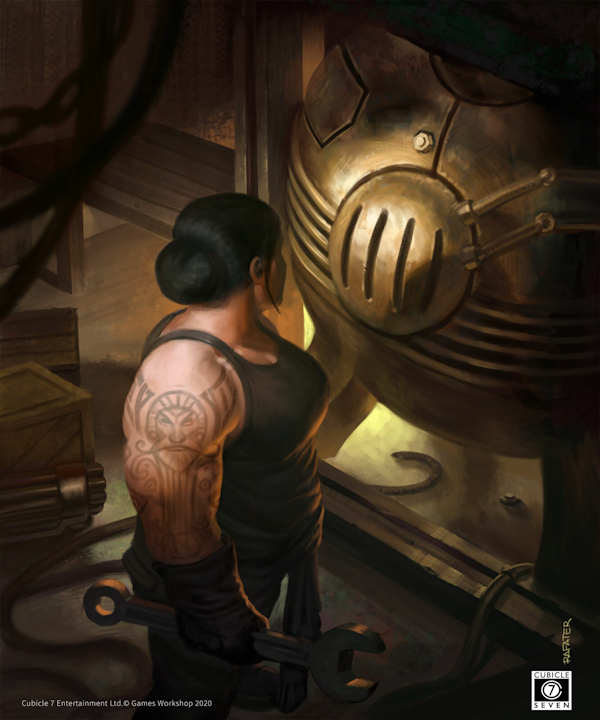
Rules
“The dice and the rules are tools for you to use to create memories. They are little cuboid wildcards that can completely flip a story on its head, and turn a moment of crushing despair into one of joyous celebration.”
This chapter expands on and further explains the basic rules. I found it helpful. Everything is well referenced and there are plenty of examples to help you follow everything.
Much of this chapter is concerned with combat. What actions you can take, how range works and so on. Combat uses the core rules and a successful hit translates directly into damage—more successes means more damage. Due to the way the difficulty of hitting an opponent is calculated, combat-focused characters can pretty reliably mince the less skilled without breaking a sweat.
The basic tenet of Soulbound’s rules is ‘don’t get bogged down in detail’. The battle map is divided into broad zones, such as a ruined fortress, the far side of a bridge or a stand of decaying trees. Turns have no specific time limit, they are simply long enough to Move and do one Action. You do have to follow a list of prescribed Actions such as Run, Hide or Prepare. But they’re broad enough to cover most situations and there’s an option to invent your own Actions if you like. All part of the writers’ strategy of giving you a standard way to play the game but encouraging you to freestyle it if you wish.
Three concepts get thoroughly explored in this section and help to explain why PCs are so dangerous and important in this game.
If, like me, you skipped ahead to the bestiary while reading this book, you might be concerned that even some of the minor foes have stats and Talents that let them go toe-to-toe with most starting Soulbound. Until you realise PCs can spend one Mettle to get an extra Action or roll with extra dice or extra Focus. And Mettle regenerates by one point each turn. So, you could run over to a Chaos Warrior, stab them, then run back out of range. Or stab the same Warrior twice. Or cast the spell that should really be too difficult for you.
Basically, every combat turn, every PC can Take A Level In Badass. It’s a very elegant and flexible mechanic.
Soulfire is even more powerful, though much harder to regain. In setting it is the energy gained by binding souls together, allowing Soulbound to draw on each other’s’ life force to accomplish feats that they could never manage alone. (Or ‘wielding the power of friendship’ as my players called it.) It allows PCs to get the maximum number of possible Successes, reroll any failed dice, heal themselves or straight-up not die when they should. It is the mechanical and in-setting reason why Soulbound are so feared.
Doom is the level of despair and chaos that has infected the land. It is directly tied to the PCs’ actions. If they mess up, the world around them gets noticeably worse. This is a good way to keep the tension up and to demonstrate just how important and epic the Soulbound and Stormcast are.
It does highlight one of the rare quibbles I have with this game though. Although you can play it how you want; the default way to play is to set up in a free city and work to protect it. Doom then directly tracks the party’s progress in defending that city and rooting out any infiltrators from the other factions. (Free cities are outposts of civilisation created and controlled by the followers of Sigmar or their allies.)
City based campaigns are fine, I’ve done them myself. But do you really want to offer us this vast setting of sun-scorched deserts, eternally regenerating forests, a literal land of the dead that still contains thriving civilisations of the living and so much more, and tell us to sit down in one corner of it?
Between Adventures
This, very brief, chapter explains the rules for down time—forging runes, recovering Soulfire, making or acquiring new acid cannons and jetpacks, teaching your pet Star Eagle new tricks, making evil blood-potions. All pretty fun stuff that gives a sense of progress.
The Mortal Realms
This chapter provides more detail on how society works in the Mortal Realms and particularly in areas under Sigmar’s influence. There’s a very convincing description of the process of founding a new free city and how various factions get involved in it. Finding a Realm Gate, cleansing the area of Chaos, building defences and so on. Lots of opportunities for adventure there.
We also get a bit more detail on the Necroquake. Basically, Nagash, god of death, tried to take over everything and it didn’t work. But it did unleash hordes of angry ghosts on every city in the Realms at once.
Then there’s a whistle-stop tour of each of the eight Mortal Realms, taking in major cities, interesting landmarks and plot seeds.
Azyr, Sigmar’s Realm, gets the least detail. Presumably because it’s relatively safe and doesn’t need heroes. It’s sort of heaven.
Aqshy, the realm of fire, gets more detail in the next chapter.
The other lands are all fantastical in their own ways.
Chamon, the realm of metal, is a constantly shifting series of sub-realms rich in ores unseen elsewhere in the cosmos. It is swarming with bizarre, metallic flora and fauna.
“Trees develop glinting, brassy or silvery bark, and water becomes acidic. Liquid gold rains from gleaming clouds, and the air becomes heavy with iron particles. Even the wildlife changes—shimmering flocks of metallic songbirds carve iridescent trails across the sky, as rust-furred predator-constructs stalk iron-limbed herd-beasts through copper grasses.”
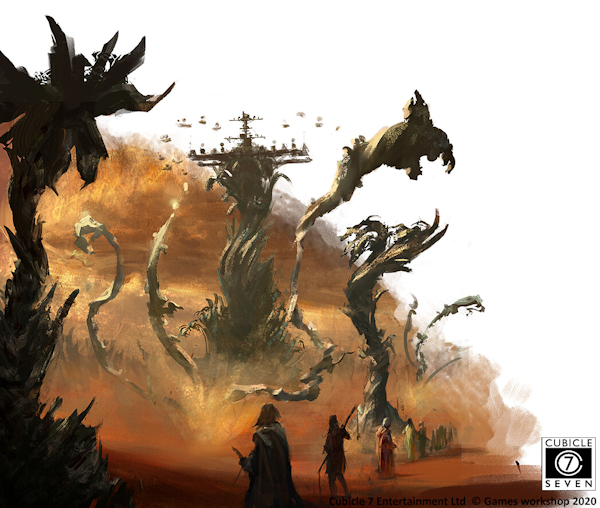
Ghur, presumably named after the noises most of its inhabitants make, is the land of beasts. It’s full of carnivores, giants, orcs and huge monsters. Interesting sights include a tribe of humans who live all their lives in massive trees. And this thing:
“The famed Crawling City rests atop the back of Shu’gohl, mightiest of the great worms, who has crawled across the Amber Steppes for generations uncounted.”
Ghyran, the realm of life (mainly plants), has wandering mountains and a Living City that was grown out of wood.
Hysh is the realm of light. (Not to be confused with the bright realm of Aqshy or the celestial realm of Azyr.) Elves called Lumineth live here but, sadly don’t contribute any character options at present. (They were only recently released for the war game.)
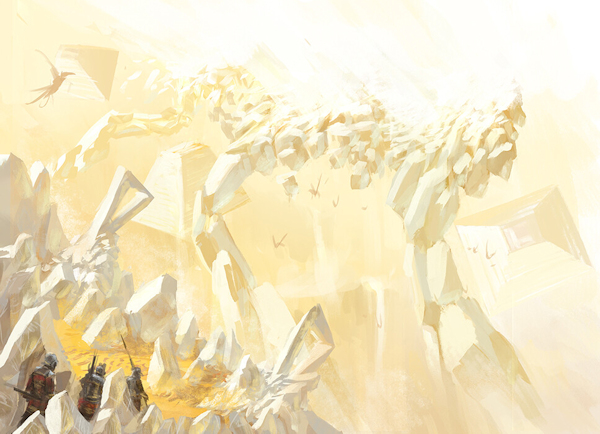
Shyish, the realm of death, is still habitable. Although Nagash is doing his best to change that.
Ulgu, the realm of shadow, is a land shrouded in mist and twilight. (But still different to Ravenloft.) It’s full of thieves, assassins and dark elves and has a bit of an old-school sword and sorcery vibe.
“Misthåvn, the so-called City of Scoundrels is one of the most unusual of Sigmar’s free cities. A port city formed by a massive collection of ships moored to the shores of Cape Tenebrax, the city can be moved across the Penumbral Sea, or even broken up into its composite ships, as necessary.”
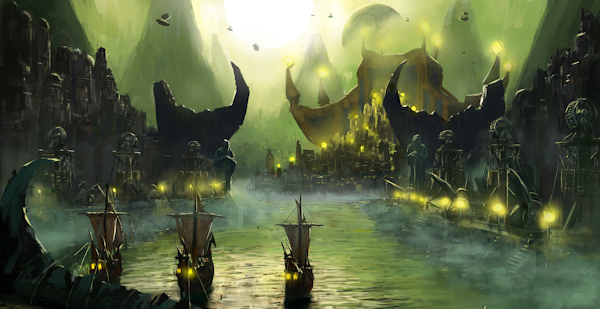
We also get descriptions of the five realms of Chaos, just in case you wanted to have a really bad holiday.
Khorne, noted skull collector and god of blood and war, has a realm of bone and brass. Which sounds kind of nice but probably isn’t.
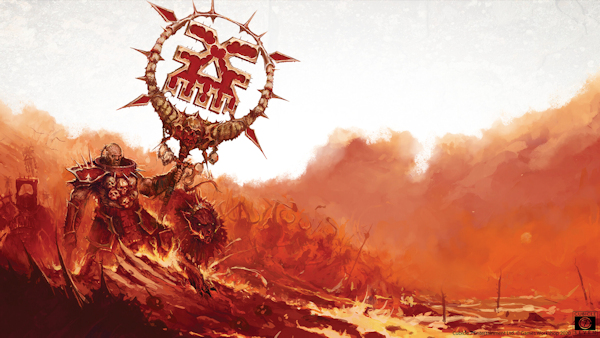
Nurgle, the jovial god of plague, has a plague garden. Because of course he does.
Tzeentch, god of mutation, magic and change, has and endless crystalline labyrinth.
“The Labyrinth is always changing, sometimes appearing as a megalopolis of glass towers, crystal monoliths, and diamond bastions. At others it is a great jungle of ruby trees and gilded lakes.”
(Actually, that does sound like it would be worth a visit.)
Slaanesh, god of pleasure and pain, isn’t here right now, due to metaplot reasons.
The Horned Rat, god of decay, rats and insane rat-people, has a city of blight.
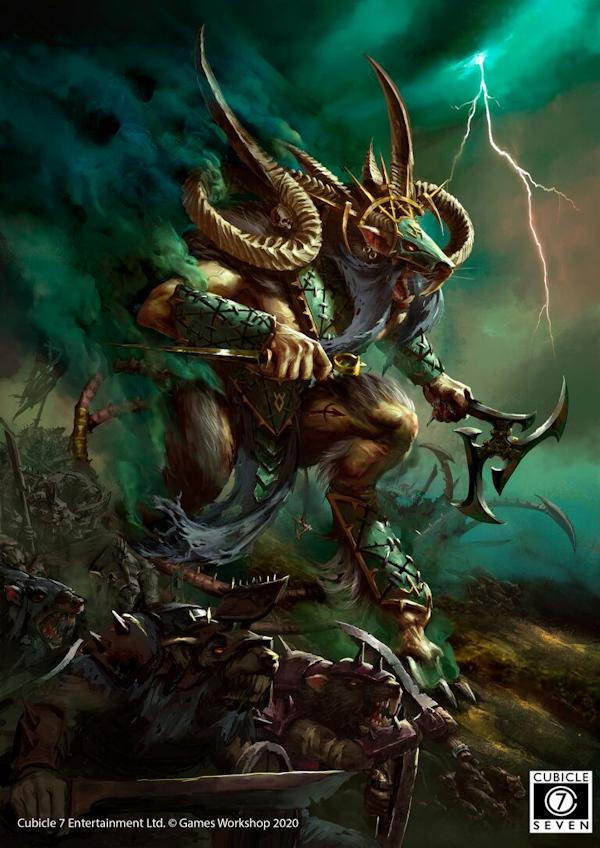
We also get a bit more detail on the various factions of Order. This filled in a couple of gaps for me, such as how the Deepkin can join Soulbindings when they usually only raid the surface dwellers and actively scrub the memories of the survivors. A few more plot seeds are thrown in as well.
Overall, this chapter presents an incredibly vast, diverse and intriguing setting. Campaigns based in different Realms could have vastly different tones and atmospheres. Anything could be over the next horizon. Entire lost civilisations and species may have found a way to survive the onslaught of Chaos and you could be the one to discover them. I really love the idea of a setting that gives you licence to throw in a new city built inside the skull of a mega-dragon or floating on clouds of electrically charged silver. Yes, it has all these established factions and bits of lore, but you could ignore all that and build your own weird setting within it.
It’s also a tremendously dangerous world where you really do have to be an army or a mighty hero to consider travelling too far outside a city. Perfect for adventuring.
The Great Parch
The Great Parch is a really big desert that covers most of the known parts of the bright realm of Aqshy. In this chapter it’s explored in considerable detail—its history, its many lands, their inhabitants and the forces that still menace them. Aqshy actually gets a significantly higher page count than the other seven Realms put together. The idea is to give you a solid starting point for your adventures.
The history of the Great Parch really emphasises the rock n’ roll nature of Age of Sigmar’s setting.
There is a fallen civilisation of light mages who used sun-lasers fired by a giant crystal to atomise an army of Khorne worshippers. And Khorne was so angry about this loss of life without the spilling of blood that he manifested a giant mailed fist and punched the mages’ floating city out of the sky.
There is a forge where corrupted dwarves bind daemons into cannons constructed of living metal and sculpt weapons of immeasurable evil.
There are rivers of blood, steaming jungles, eternally burning forests, wondrous lost cities, a sea of acid and a sea bedecked in rainbow hues. It’s a wonderfully dramatic landscape with no pretensions towards realism.
There are some more human elements and conflicts to ground the setting a bit. A people who used to live by trade and still prize the craft of merchants. Another people who are proud descendants of the old mage empires. And the arrogant Azyrite newcomers who claim to have saved the locals from the ravages of Chaos. It’s enough flavour to allow you to build characters who hail from these lands.
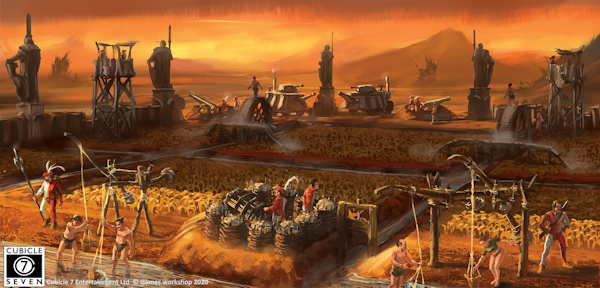
Crafting adventures should be easy enough too. The Great Parch is strewn with marauding bands of Chaos raiders, ghosts, ratmen and other horrors and every other landmark is home to some murderous dark lord.
“Within the skull of an ancient, winged serpent so large its spine crosses several mountains. The hideous fortress is formed of bone blended with enchanted steel, continually shrieking from hundreds of cunningly carved mouths that channel the winds of the mountains into an endless cacophony.”
Religion and Belief
This chapter goes through each of the gods of the setting and details their history, creed and current plans. They all get excellent character portraits as well with Nagash and Grimnir in particular stealing the show. It’s interesting to imagine a time when the noble Sigmar worked alongside the power-hungry and morbid Nagash and the violent and barbaric Gorkamorka (the god of orruks and ogors aka orcs and ogres).
(But then, Sigmar still works alongside the dark aelf gods Malerion and Morathi and they are not good people.)
Magic
Magic uses the same core mechanics as the rest of the game and my players and I found it fairly easy to get the hang of.
Magic in the Age of Sigmar setting has some quirks left over from Warhammer Fantasy. For example, Light Magic and Bright Magic are distinct from one another. As are Amber Magic and Gold Magic. This takes a little bit of getting used to but the short descriptions of each type of magic at the start of this chapter make it all clear enough.
Aside from the eight Lores of magic associated with the eight Mortal Realms, there is Chaos Magic and the Magic of the Deeps. And the door is left open for “other mysterious forms of magic”. (Which is good, never shut the door on magic.)
As with Miracles, there is a selection of generic Spells that allows for any mage to cover the basics. Mages get more Spells than Blessed get Miracles. While any Spell can be learned from a Lore the Mage knows, some are more powerful and so more difficult to cast. Failing a Channelling (spellcasting) roll leads to potentially horrible consequences. This organically limits the power of a Mage character without anyone having to muck around with spell levels and the like. And it balances out the increased versatility Mages have compared to Blessed. It also means that a PC could spend Mettle and/or Soulfire to cast a spell which would normally be too risky for them.
Each style of magic has its own flavour, which encourages Mage characters to learn more Lores and expand their abilities. For example:
Bright Magic (fire magic) is good for high level devastation, Amber Magic (plants and life) is good for controlling the battlefield and buffing yourself or allies. Celestial Magic has a bit of healing, some strategic options such as a very dramatic teleportation spell and the ability to drop a comet on your enemies. Grey Magic is mostly about mind control, tricks and illusions, though you can also summon a flying shadow horse or hurl an enemy into the pit of shades!
There’s some good creativity on display here. Gold Magic, the Lore of metal, lets you improve armour but also allows you to give a surface a frictionless metallic sheen. I can just imagine the fun that players would have sending a squad of Chaos knights sliding into a pit of lava or off the side of a cliff.
Deep Magic is my favourite. It’s so Goth! Fill an enemy’s lungs with seawater, crush them with pressure, or shield yourself from their eyes with abyssal darkness.
But pretty much all of these Lores of magic make you feel like a badass.
This chapter also describes Endless Spells, these are extraordinarily powerful and predatory spells that have a mind of their own. As if the Mortal Realms weren’t dangerous enough!
There’s also a breakdown of how to design your own spells. This book really does cater to both the ‘pick up and play’ and the ‘I want to do it my way’ crowds.
The Game Master
Honestly, there’s so much solid advice for new Game Masters (GMs) in this book that a separate section seems almost redundant. But the authors do pack in some useful ideas. All the usual modern RPG advice is there, such as how to run a Session 0. It’s all done in a very gentle, encouraging and positive style, clearly aimed at new players and GMs.
There’s some nice advice on making suitably fantastical locations. This is not low-magic, pseudo-historical fantasy. This is high-magic, wacky, heavy metal album cover fantasy. Don’t just have your characters ride up to a castle. Build the castle of out of crystal and have it surrounded by a perpetual rain of ice!
There’s also a fairly mechanical process for introducing a potential threat and allowing it to escalate if it’s not dealt with. I don’t think I’d use it myself, but I could see it being a useful tool for new GMs.
There’s a handy and very visual table that explains how difficult a task will be based on the number of dice available and the target number. Much appreciated and a boon for the maths-averse or new GM.
This chapter also gives advice on modding and altering the game to suit your own tastes. Creating and modifying Archetypes. Creating new species. Playing in a different era or with weaker characters. All great ways to get more out of this book.
(Though I’m sure future games or supplements will cover other species and factions in more detail.)
Bestiary
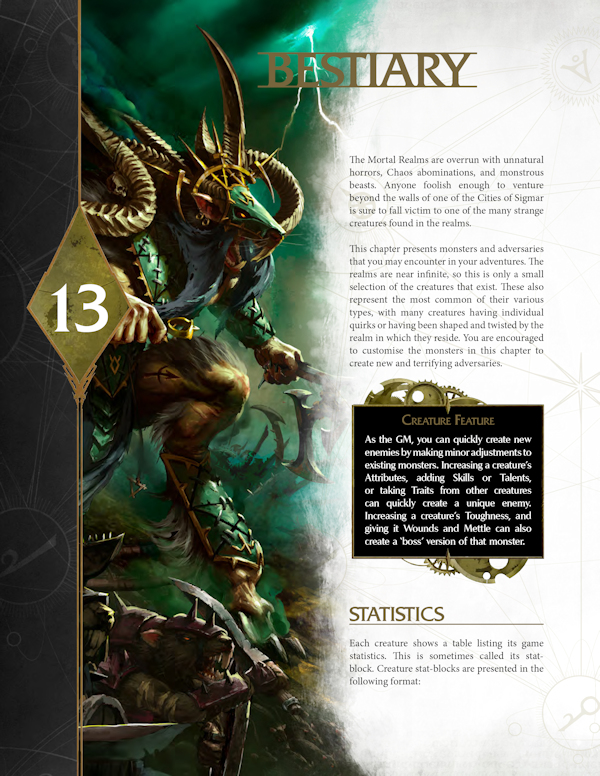 I had a friend who loves the Age of Sigmar wargame and lore, look this book over. He liked the art, lore information and layout and was keen to play the game itself. His only criticism was, to him, the bestiary felt a bit lacking and didn’t really showcase the setting. But then, he is far more familiar than I am with the dozens of different monsters and warriors that rampage through the Mortal Realms on a daily basis. As a newcomer to the setting I thought it was a fairly solid and fun bestiary that gives the reader a taste of most of the evil factions and an idea of what it would be like to fight them.
I had a friend who loves the Age of Sigmar wargame and lore, look this book over. He liked the art, lore information and layout and was keen to play the game itself. His only criticism was, to him, the bestiary felt a bit lacking and didn’t really showcase the setting. But then, he is far more familiar than I am with the dozens of different monsters and warriors that rampage through the Mortal Realms on a daily basis. As a newcomer to the setting I thought it was a fairly solid and fun bestiary that gives the reader a taste of most of the evil factions and an idea of what it would be like to fight them.
Beastmen and ratmen, plague daemons and pleasure daemons, orcs and trolls. Each faction and sub-faction gets a few lines on how to use them in your game, a welcome inclusion. There’s also a solid mix of weak and strong opponents. Crazed Blood Warriors present enough of a challenge that starting PCs will need to play to their own strengths and make the most of their Mettle to overcome them. The mighty, liquid-flame-spewing Magmadroth is a devastating, end-game threat. But any Skaven Clanrats who get near a Soulbound will be slaughtered in droves.

The Hordes of Nagash stood out to me. Undead are a staple foe in fantasy RPGs and often default to fairly dull and generic skeletons and zombies. In Soulbound, the restless dead are represented by deluded Ghoul knights as well as things called Terrorgheists, Ossiarch Bonereapers, Glaivewraiths and Chainrasp Dreadwardens. Just writing that sentence got me keyed up and ready for (simulated) battle. (More awesome art helped with that.)
Turns out a setting designed to sell cool models has some really evocative creatures to fill out its rogues’ gallery. I would have liked more monsters but I’m sure future supplements will deliver them.
It’s relatively easy to put together your own monsters as well, so don’t fret too much if your favourite abomination didn’t make the cut.
I did find the layout of this chapter a little less intuitive than the rest of the book. Monster stat sheets are interweaved with their lore descriptions and aren’t always on the same page. A mild irritation which stood out all the more because of how well thought-out the layout was elsewhere.
Conclusion
Soulbound is clearly intended to gently lead people out of the blood-drenched wilderness of wargaming and into the equally blood-drenched wilderness of roleplaying. It’s a great book; well put together, beautifully illustrated, and often fun to read.
If you like the Age of Sigmar wargame or any high-fantasy or gonzo setting, this book is worth a look. If you’re a new GM looking for a meaty but accessible game to sink your teeth into, this book has got you covered. If you want a combat-focused game which you can take to pieces and use to build or model your own setting, this book should do the trick.
Hail Sigmar.
Disclaimer: I received a digital copy of this book in return for an honest review.

